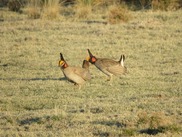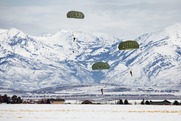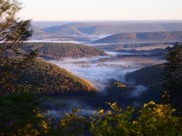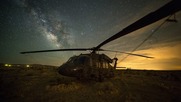|
Announcing 2024 Sentinel Landscapes to Address Climate Change Impacts and Strengthen Military Readiness |
|
|
Today, the Sentinel Landscapes Partnership, comprised of the U.S. Department of Agriculture (USDA), Department of Defense (DOD), and Department of the Interior (DOI), announced the designation of five new sentinel landscapes. In these landscapes, natural and working lands thrive alongside military installations and ranges. The partnership is excited to welcome these new landscapes and support their partners' work to mitigate climate change impacts and improve sustainable land and water management practices around military installations.
The 2024 Sentinel Landscape Designations include:
Eastern New Mexico Sentinel Landscape, New Mexico
Great Salt Lake Sentinel Landscape, Utah
Hawaiʻi Sentinel Landscape, Kauaʻi, Oʻahu, and Hawaiʻi Island
Kittatinny Ridge Sentinel Landscape, Pennsylvania
Mojave Desert Sentinel Landscape, California
"The Sentinel Landscapes Partnership provides DOD with the unique opportunity to expand and diversify our partnerships with non-governmental organizations, state and local governments, Tribes and land managers to enhance the resilience of military installations and the local communities that support them," said Brendan Owens, Assistant Secretary of Defense for Energy, Installations and Environment. "This year, the Department is excited to support the five newly designated landscapes in achieving their dual priorities of safeguarding national defense and enhancing installation and community resilience, particularly in the Pacific and Western regions.”
“The USDA Forest Service is proud to participate in the Sentinel Landscapes Partnership,” said Randy Moore, USDA Forest Service Chief. “We are committed to investing in sustainable land use practices with our fellow federal partners in the spirit of shared stewardship. The Sentinel Landscapes Partnership provides support to military readiness while securing conservation benefits, bolstering forest economies, increasing public access to outdoor recreation, and providing wildfire risk reduction for communities.”
“Through the Sentinel Landscapes Partnership, we have worked with private landowners to permanently protect more than 515,000 acres and implement sustainable management practices on an additional 2.7 million acres around military testing and training areas,” said Terry Cosby, USDA Natural Resources Conservation Service Chief. “These efforts preserve wildlife habitat, bolster agricultural and forest production, and support climate resiliency, among other benefits, while at the same time ensuring our military has the space it needs for its operations. This work showcases the power of collaboration and partnership to help us meet our mission.”
"The Sentinel Landscapes Partnership demonstrates the remarkable successes that can happen through collaborative, locally led conservation efforts," said Martha Williams, U.S. Fish and Wildlife Service Director. "This program works by connecting private landowners with voluntary state and federal assistance programs that provide tax reductions, agricultural loans, disaster relief, educational opportunities, technical aid, and funding for conservation easements. By focusing multiple agencies' resources on a Sentinel Landscape, the Service and its partners use taxpayer dollars more efficiently and achieve greater conservation outcomes."
Read more about the Sentinel Landscapes Partnership’s mission and accomplishments at www.sentinellandscapes.org.
|
|
Mark Your Calendars: 2024 Designation Cycle Sentinel Landscapes Spotlight Webinar
Join the Sentinel Landscapes Partnership on Wednesday, July 24, from 1:00 PM to 2:00 PM Eastern Time to learn about the newly designated landscapes. During this webinar, representatives from selected landscapes will explore their history, priorities, and alignment with the mission of the Sentinel Landscapes Partnership. Additionally, presenters will share best practices and insights on why they believe their applications were successful.
|
|
About the 2024 Sentinel Landscapes
Eastern New Mexico Sentinel Landscape, New Mexico

The Eastern New Mexico Sentinel Landscape, covering over 2.4 million acres, is anchored by Cannon Air Force Base and Melrose Air Force Range, which provide training and testing opportunities for the 27th Special Operations Wing, 26th Special Tactics Squadron, and 43rd Intelligence Squadron. The landscape boundary overlaps with the Ogallala Aquifer, the sole source of domestic water for Cannon Air Force Base and its surrounding communities. Partners are focused on safeguarding water supplies; sustaining installation and community resilience to the impacts of intensive agriculture and climate change; enhancing wildlife habitats by promoting grasslands and restoring playas; protecting working agricultural lands and advancing innovations for sustainable farming; and building community partnerships through education and training.
|
Great Salt Lake Sentinel Landscape, Utah

The Great Salt Lake Sentinel Landscape, spanning over 2.7 million acres in northern Utah, contains the Western Hemisphere’s largest saline lake and four military installations with unique missions and capabilities. Hill Air Force Base, Camp Williams, Tooele Army Depot, and Air Force Little Mountain Test Facility offer extensive training, testing, and logistical support for all the Military Services. As Utah is one of the fastest growing and driest U.S. states, partners will focus on mitigating encroachment through mutually beneficial land management programs; managing wildfires; building resilience in Utah’s military installations; protecting migratory bird and mule deer migration corridors through projects that safeguard critical habitats; and bolstering installation and community resilience by enhancing and protecting water sources and the Great Salt Lake ecosystem.
|
Hawaiʻi Sentinel Landscape, Kauaʻi, Oʻahu, and Hawaiʻi Island

The Hawaiʻi Sentinel Landscape spans over two million acres and includes priority conservation, agricultural, and military mission lands on the islands of Kauaʻi, Oʻahu, and Hawaiʻi Island. Rapid urban and residential development threatens essential agricultural lands, native forests, and critical habitats, while also obstructing low elevation flight and drone training, radar, and communication antennas. Similarly, climate threats, extreme weather anomalies, and sea level rise impacts military readiness, community resilience, and cultural resources. Partners are focused on promoting land use that is compatible with military missions by safeguarding and maintaining open lands that support agriculture, conservation, and recreation; providing landowners and land managers with effective management tools and protection measures to support threatened and endangered species populations; supporting a landscape that is resilient to the impacts of increased severe weather events, sea level rise, and wildfire; and developing initiatives that foster the sustained well-being of Hawaiʻi's conservation areas, working lands, and local communities.
|
Kittatinny Ridge Sentinel Landscape, Pennsylvania

In the Lenape language, Kittatinny means “Big Mountain.,” which describes the geography of Kittatinny Ridge Sentinel Landscape well. Located in eastern Pennsylvania’s Appalachian Mountains, it encompasses forested ridges and fertile valleys that provide clean water, sequester vast amounts of carbon, and serve as a crucial corridor for rare wildlife and songbird migration. The landscape is anchored by Fort Indiantown Gap, the busiest National Guard training center, the Army’s second busiest heliport, and one of only three specialized Army National Guard aviation facilities. With the primary mission of preserving military mission readiness, operations, testing and training capabilities, KRSL partners are focused on increasing coordinated and holistic land conservation, natural resource protection, and stewardship initiatives; supporting working lands productivity and economic development; and improving nature-based recreational resources and access to sustain small-town economies.
|
Mojave Desert Sentinel Landscape, California

The Mojave Desert Sentinel Landscape in California covers about 3.5 million acres of the western Mojave Desert and is located north of Los Angeles and the Inland Empire. Increasingly under pressure from development and climate change, this region is home to the Marine Corps Air Ground Combat Center, National Training Center Fort Irwin, Edwards Air Force Base, Naval Air Weapons Station China Lake, and Marine Corps Logistics Base Barstow, multi-mission public lands, and dozens of endangered and threatened species. The sentinel landscape brings together a diverse group of state and local, Federal, Tribal, and non-governmental organization partners focused on increasing climate resilience among species and ecosystems; reclaiming and rehabilitating up to 50,000 acres of priority habitats; and mitigating encroachment, incompatible development, and the impacts of wildfires and climate change. These partner efforts support critical military missions while safeguarding listed species and vulnerable ecosystems.
|
|
|
|
|
|